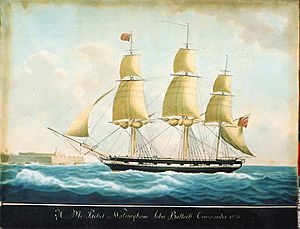Walsingham (1795 ship) facts for kids
class="infobox " style="float: right; clear: right; width: 315px; border-spacing: 2px; text-align: left; font-size: 90%;"
| colspan="2" style="text-align: center; font-size: 90%; line-height: 1.5em;" | 
|}
Walsingham (also known as Walsingham Packet) was a special type of ship called a packet. She was built in 1795 in Falmouth, England. Soon after she was launched, a French privateer ship captured her. However, the British Royal Navy quickly got her back. In 1815, she bravely fought off an American privateer in a famous sea battle. Walsingham worked for the Post Office until 1826 when she was sold. Sadly, she was wrecked in 1828.
Contents
| History | |
|---|---|
| Name | Walsingham |
| Operator | Postal Service (1795-1826) |
| Builder | Hill & Mellish, Limehouse |
| Launched | 1795 |
| Fate | Wrecked 1828 |
| General characteristics | |
| Tons burthen | 17448⁄94, or 180, or 185 (bm) |
| Length | 82 ft 0 in (25.0 m) |
| Beam | 23 ft 4 in (7.1 m) |
| Complement | 1815:15 |
| Armament |
|
Walsingham's Journey
Hill & Melish built Walsingham for the Post Office Packet Service. This service delivered mail and important messages across the seas. Even though the Post Office used her, the ship's captains actually owned and managed her. Walsingham sailed to many places, including Portugal, Brazil, North America, Jamaica, and Malta.
Captured and Recaptured
On September 26, 1795, two British ships, Porcupine and Minotaur, recaptured Walsingham Packet. A French ship called Insolent had captured Walsingham Packet on September 13. At that time, Walsingham Packet, captained by Mr. Bell, was sailing from Falmouth to Lisbon. The French ship Insolent had 18 guns and 90 men. Insolent barely escaped being captured herself when the British ships arrived. She managed to get into Lorient harbor just in time.
Walsingham Packet was carrying goods when she was captured. The owners of these goods, from Britain and Portugal, tried to get them back. But the French captors argued that packet ships were not allowed to carry commercial goods. A judge named Sir William Scott said the cargo owners could not claim the goods.
A Close Call in Portugal
On November 27, 1807, Lloyd's List reported that Walsingham Packet arrived in Falmouth. She was carrying mail from Lisbon. She had left Lisbon on November 4 after shore batteries (guns on land) fired at her near the Tagus River.
On October 22, the Portuguese government had announced that all their ports were closed to British ships. This was because of Napoleon's demands as he tried to control trade in Europe. Mr. Chamberlain, the Post Office's agent in Lisbon, sent this news on October 27. He thought all British people might be arrested in Portugal. So, he hired a small armed schooner (a type of ship) to wait for him off the coast.
On November 11, the Portuguese government decided to arrest all British people, except for the ambassador. Mr. Chamberlain walked to the coast, but his schooner had already left. He tried to reach other British ships, but the waves were too strong. Finally, he reached Walsingham. The day before, shore batteries had fired at Walsingham. She was waiting offshore to find out what was happening. When Mr. Chamberlain arrived and told them the news, Walsingham quickly sailed for Falmouth.
New Routes and Brave Fights
In July 1808, the Post Office moved Walsingham from the Lisbon route to serve Brazil. This happened because the Portuguese government had moved to Rio de Janeiro.
In 1813, Lloyd's Register began listing the Falmouth packets. It showed Walsingham with Roberts as owner, later changing to Bullock. Her owner was listed as Captain and Co.
On February 11, 1815, Walsingham was sailing to Jamaica. She was about 100 miles away from land and under the command of Captain William Nichols. She saw a schooner that was faster than her. The schooner came closer and raised a British blue flag. Captain Nichols was not fooled. He prepared his guns, moving two 9-pounder guns to the back of the ship to fire backwards.
As the schooner got closer, it was clear she was an American ship. She had twelve long 9-pounder guns. Her front deck was full of men ready to board Walsingham. The two ships fired their guns at each other for half an hour. The American ship's masts and ropes were badly damaged. The British thought about trying to capture her, but the American ship managed to sail away. Walsingham had five men injured. When she arrived in Jamaica, local merchants raised about £500. They used this money to give Captain Nichols an honor sword and reward his crew.
End of Service
After the Napoleonic Wars ended, packet ships like Walsingham had fewer weapons and crew. Walsingham set a record for the fastest trip to Rio de Janeiro. She made the round trip in 82 days between August and November 1817. She continued to serve until the Royal Navy took over mail delivery.
Walsingham was last listed in Lloyd's Register as a Falmouth packet in 1825. J. Bullock was her master and owner. In 1826, Walsingham was sold to Neill & Co. The 1826 Lloyd's Register showed her master changed from Bullock to Bourke. Her owner changed from Capt. & Co. to Neal. Her route changed from Falmouth to London–Cape of Good Hope.
Walsingham's Final Voyage
On June 15, 1828, Walsingham was pushed ashore by a storm and wrecked at the Cape of Good Hope.
A New Walsingham?
There is a project to get money to build a copy of Walsingham in Falmouth. The first step of this project is to build Lucy. Lucy will be a small boat from that time period. She will be a 20 ft (6.1 m) gaff rigged cutter. She will be built with smooth planks and have a rounded front.

